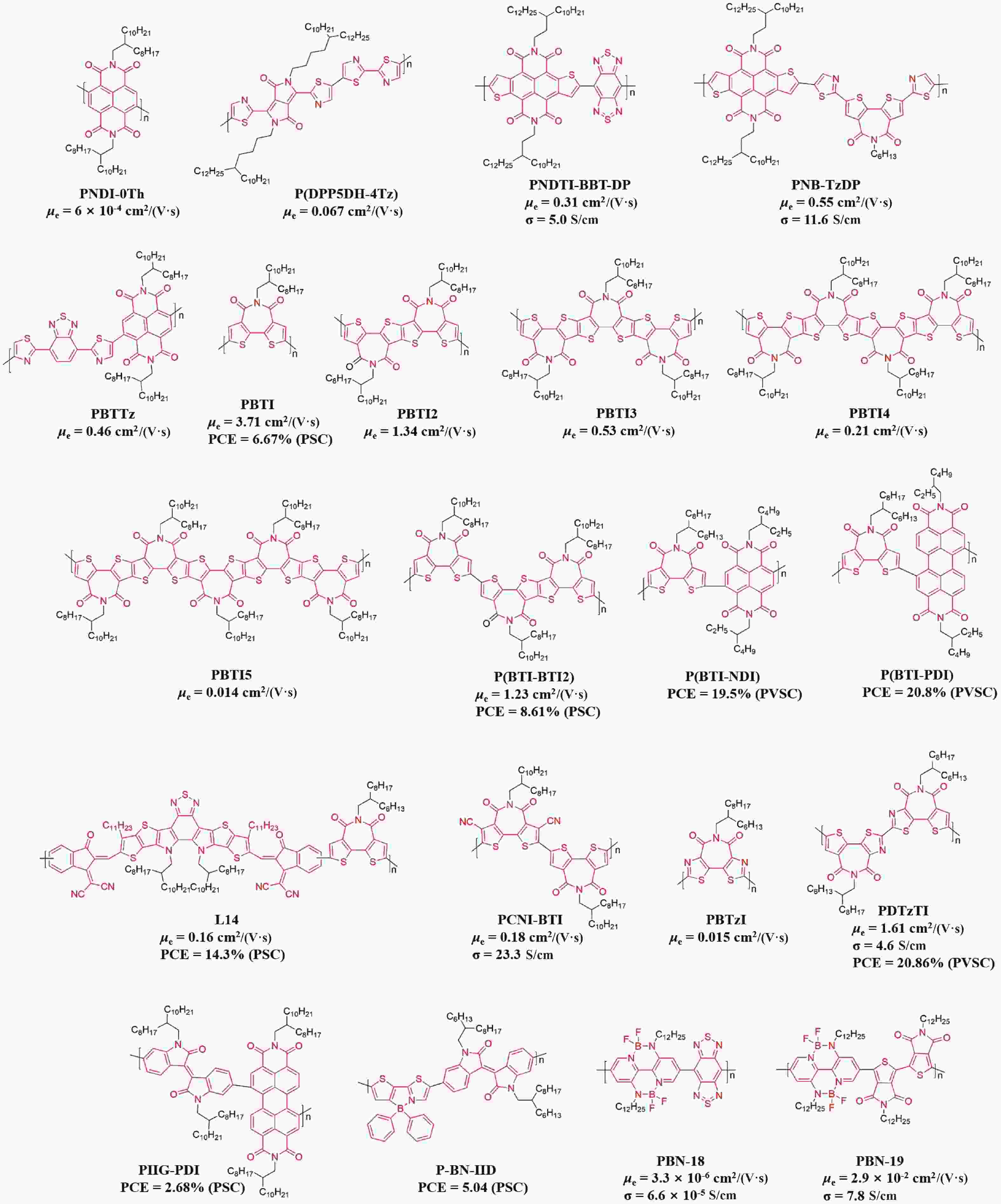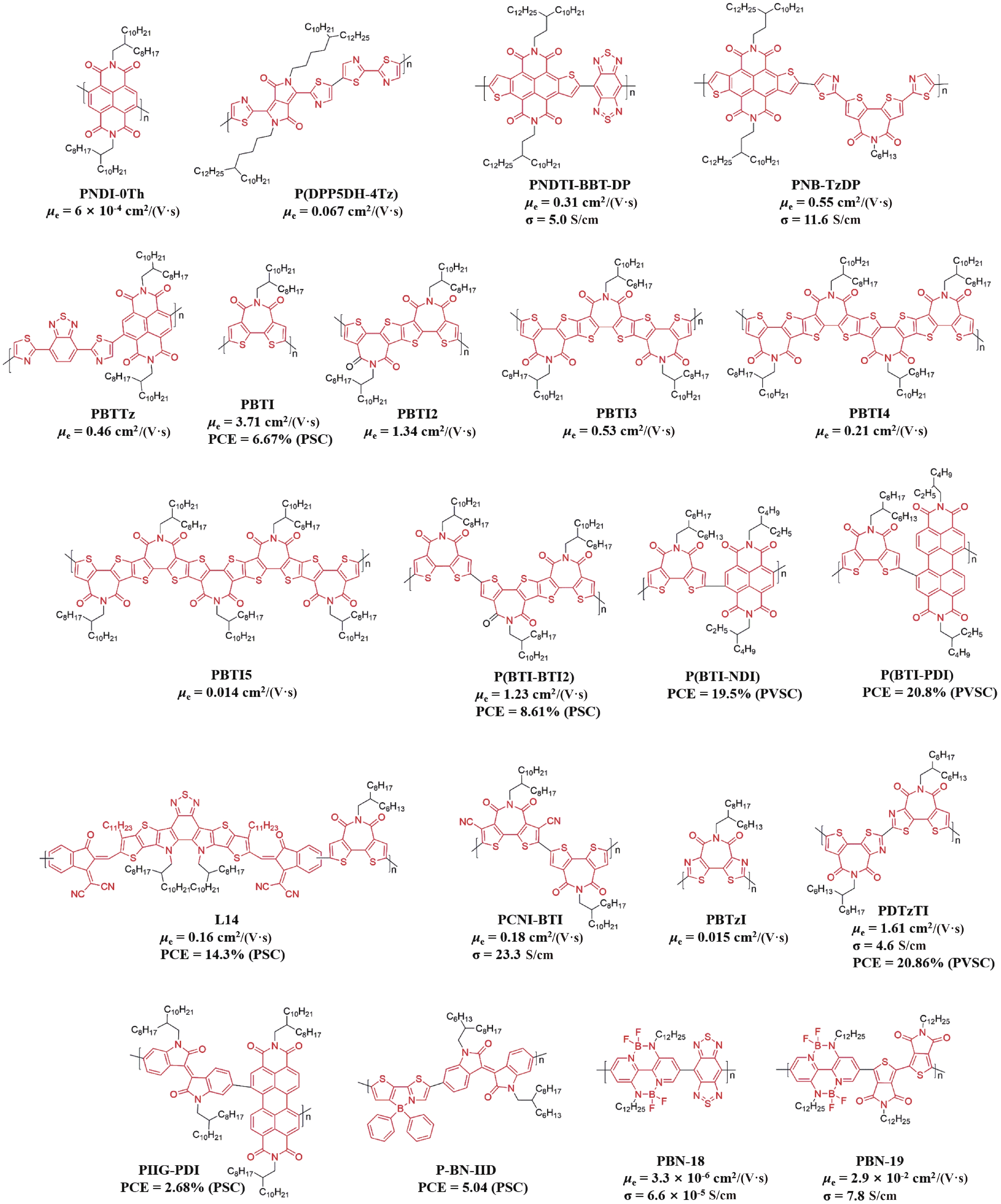| Citation: |
Yongqiang Shi, Liming Ding. n-Type acceptor–acceptor polymer semiconductors[J]. Journal of Semiconductors, 2021, 42(10): 100202. doi: 10.1088/1674-4926/42/10/100202
Y Q Shi, L M Ding, n-Type acceptor–acceptor polymer semiconductors[J]. J. Semicond., 2021, 42(10): 100202. doi: 10.1088/1674-4926/42/10/100202.
Export: BibTex EndNote
|
n-Type acceptor–acceptor polymer semiconductors
doi: 10.1088/1674-4926/42/10/100202
More Information-
References
[1] Guo X, Facchetti A, Marks T J. Imide-and amide-functionalized polymer semiconductors. Chem Rev, 2014, 114, 8943 doi: 10.1021/cr500225d[2] Liu Q, Jiang Y, Jin K, et al. 18% efficiency organic solar cells. Sci Bull, 2020, 65, 272 doi: 10.1016/j.scib.2020.01.001[3] Jin K, Xiao Z, Ding L. D18, an eximious solar polymer!. J Semicond, 2021, 42, 010502 doi: 10.1088/1674-4926/42/1/010502[4] Tang A, Xiao Z, Ding L, et al. ~1.2 V open-circuit voltage from organic solar cells. J Semicond, 2021, 42, 070202 doi: 10.1088/1674-4926/42/7/070202[5] Jin K, Xiao Z, Ding L. 18.69% PCE from organic solar cells. J Semicond, 2021, 42, 060502 doi: 10.1088/1674-4926/42/6/060502[6] Ji X, Xiao Z, Sun H, et al. Polymer acceptors for all-polymer solar cells. J Semicond, 2021, 42, 080202 doi: 10.1088/1674-4926/42/8/080202[7] Jin K, Hao F, Ding L. Solution-processable n-type organic thermoelectric materials. Sci Bull, 2020, 65, 1862 doi: 10.1016/j.scib.2020.07.036[8] Zhang F, Di C. Exploring thermoelectric materials from high mobility organic semiconductors. Chem Mater, 2020, 32, 2688 doi: 10.1021/acs.chemmater.0c00229[9] Lu Y, Wang J, Pei J. Strategies to enhance the conductivity of n-type polymer thermoelectric materials. Chem Mater, 2019, 31, 6412 doi: 10.1021/acs.chemmater.9b01422[10] Yan X, Xiong M, Li J, et al. Pyrazine-Flanked diketopyrrolopyrrole (DPP): A new polymer building block for high-performance n-type organic thermoelectrics. J Am Chem Soc, 2019, 141, 20215 doi: 10.1021/jacs.9b10107[11] Liu J, Ye G, Zee B, et al. N-type organic thermoelectrics of donor–acceptor copolymers: Improved power factor by molecular tailoring of the density of states. Adv Mater, 2018, 30, 1804290 doi: 10.1002/adma.201804290[12] Ke L, Ding L. Perovskite crystallization. J Semicond, 2021, 42, 080203 doi: 10.1088/1674-4926/42/8/080203[13] Li B, Yang K, Liao Q, et al. Imide-functionalized triarylamine-based donor-acceptor polymers as hole transporting layers for high-performance inverted perovskite solar cells. Adv Funct Mater, 2021, 2100332 doi: 10.1002/adfm.202100332[14] Wang Y, Chen W, Wang L, et al. Dopant-free small-molecule hole-transporting material for inverted perovskite solar cells with efficiency exceeding 21%. Adv Mater, 2019, 31, 1902781 doi: 10.1002/adma.201902781[15] Yang J, Zhao Z, Wang S, et al. Insight into high-performance conjugated polymers for organic field-effect transistors. Chem, 2018, 4, 2748 doi: 10.1016/j.chempr.2018.08.005[16] Durban M M, Kazarinoff P D, Luscombe C K. Synthesis and characterization of thiophene-containing naphthalene diimide n-type copolymers for OFET applications. Macromolecules, 2010, 43, 6348 doi: 10.1021/ma100997g[17] Wang Y, Nakano M, Michinobu T, et al. Naphthodithiophenediimide–benzobisthiadiazole-based polymers: Versatile n-type materials for field-effect transistors and thermoelectric devices. Macromolecules, 2017, 50, 857 doi: 10.1021/acs.macromol.6b02313[18] Wang Y, Takimiya K. Naphthodithiophenediimide–bithiopheneimide copolymers for high-performance n-type organic thermoelectrics: Significant impact of backbone orientation on conductivity and thermoelectric performance. Adv Mater, 2020, 32, 2002060 doi: 10.1002/adma.202002060[19] Wang Y, Hasegawa T, Matsumoto H, et al. Significant difference in semiconducting properties of isomeric all-acceptor polymers synthesized via direct arylation polycondensation. Angew Chem Int Ed, 2019, 58, 11893 doi: 10.1002/anie.201904966[20] Yuan Z, Fu B, Thomas S, et al. Unipolar electron transport polymers: A thiazole based all-electron acceptor approach. Chem Mater, 2016, 28, 6045 doi: 10.1021/acs.chemmater.6b01929[21] Wang Y, Guo H, Ling S, et al. Ladder-type heteroarenes: Up to 15 rings with five imide groups. Angew Chem Int Ed, 2017, 56, 9924 doi: 10.1002/anie.201702225[22] Shi Y, Guo H, Qin M, et al. Imide-functionalized thiazole-based polymer semiconductors: Synthesis, structure–property correlations, charge carrier polarity, and thin-film transistor performance. Chem Mater, 2018, 30, 7988 doi: 10.1021/acs.chemmater.8b03670[23] Shi Y, Guo H, Qin M, et al. Thiazole imide-based all-acceptor homopolymer: Achieving high-performance unipolar electron transport in organic thin-film transistors. Adv Mater, 2018, 30, 1705745 doi: 10.1002/adma.201705745[24] Liu J, Shi Y, Dong J, et al. Overcoming coulomb interaction improves free-charge generation and thermoelectric properties for n-doped conjugated polymers. ACS Energy Lett, 2019, 4, 1556 doi: 10.1021/acsenergylett.9b00977[25] Chen W, Shi Y, Wang Y, et al. N-type conjugated polymer as efficient electron transport layer for planar inverted perovskite solar cells with power conversion efficiency of 20.86%. Nano Energy, 2020, 68, 104363 doi: 10.1016/j.nanoen.2019.104363[26] Wang Y, Guo H, Harbuzaru A, et al. (Semi)ladder-type bithiophene imide-based all-acceptor semiconductors: Synthesis, structure–property correlations, and unipolar n-type transistor performance. J Am Chem Soc, 2018, 140, 6095 doi: 10.1021/jacs.8b02144[27] Shi Y, Guo H, Huang J, et al. Distannylated bithiophene imide: Enabling High-performance n-type polymer semiconductors with an acceptor–acceptor backbone. Angew Chem Int Ed, 2020, 59, 14449 doi: 10.1002/anie.202002292[28] Sun H, Yu H, Shi Y, et al. A narrow-bandgap n-type polymer with an acceptor–acceptor backbone enabling efficient all-polymer solar cells. Adv Mater, 2020, 32, 2004183 doi: 10.1002/adma.202004183[29] Shi Y, Chen W, Wu Z, et al. Imide-functionalized acceptor–acceptor copolymers as efficient electron transport layers for high-performance perovskite solar cells. J Mater Chem A, 2020, 8, 13754 doi: 10.1039/D0TA03548C[30] Feng K, Guo H, Wang J, et al. Cyano-functionalized bithiophene imide-based n-type polymer semiconductors: synthesis, structure –property correlations, and thermoelectric performance. J Am Chem Soc, 2021, 143, 1539 doi: 10.1021/jacs.0c11608[31] Wang X, Lv L, Li L, et al. High-performance all-polymer photoresponse devices based on acceptor –acceptor conjugated polymers. Adv Funct Mater, 2016, 26, 6306 doi: 10.1002/adfm.201601745[32] Zhao R, Dou C, Xie Z, et al. Polymer acceptor based on B←N units with enhanced electron mobility for efficient all-polymer solar cells. Angew Chem Int Ed, 2016, 55, 5313 doi: 10.1002/anie.201601305[33] Dong C, Deng S, Meng B, et al. Distannylated monomer of strong electron-accepting organoboron building block: Enabling acceptor–acceptor type conjugated polymers for n-type thermoelectric applications. Angew Chem Int Ed, 2021, in press doi: 10.1002/anie.202105127 -
Proportional views






 DownLoad:
DownLoad:














